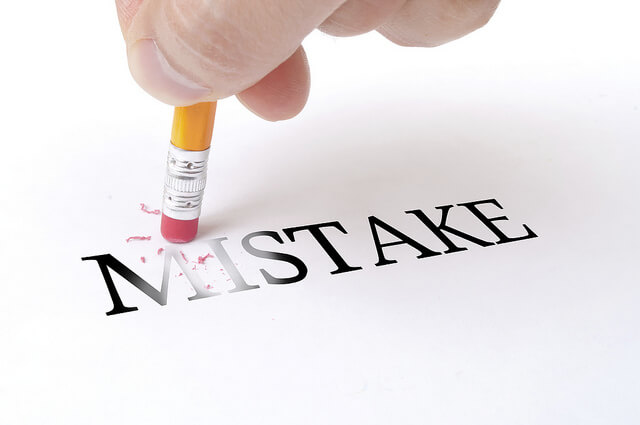
Whether you’re just starting out or have been optimising your content for a while, you know there are a lot of variables that go into search engine optimisation. With so many different decisions to make and things to consider, few people get SEO completely right their first time around.
Mistakes are likely to happen, and some of those makes can be very costly.
Falling just a few spots in the rankings can dramatically affect your bottom line. The number one ranking in Google receives about 15% more traffic than the number two spot and about 20% more traffic than number three.
There isn’t a lot of room for error, so before you make another decision, read about these 7 fatal mistakes that could destroy your entire SEO program.
1) Targeting The Wrong Keywords
You could be the best shot in the world, but if you’re aiming at the wrong target, it doesn’t really matter.
It’s hard to overstate how important it is to target the right keywords. Both search engines and consumers use them to find your site.
Targeting the wrong keywords may still bring a lot of traffic, but those consumers probably aren’t going to convert because they’re probably not looking for exactly what you’re offering.
If your conversions aren’t where they’re supposed to be, this might be the problem.
Make sure you’re targeting words and phrases that customers use when they’re looking for a site like yours. This may seem obvious, but some companies target keywords that they think are associated with their website. In reality, those keywords might not actually be relevant, and it’s killing their conversions.
Action Steps:
– Use a keyword suggestion tool like Ubersuggest to research relevant keywords.
– Identify your keywords, check them, check them in respects to your competition, and then re-check them in respects to your own site once more—it’s too important not to!
– Then leverage Google’s Keyword Planner to develop a solid new search campaign.
2) Disregarding The Meta Description And Title Tags
When words are all you have to attract customers, you better use them wisely.
The meta description is the short description you see underneath the title tag in the SERPs. Visually, there isn’t much that separates one search result from another, so it’s up to you to use the meta description and the title to catch a consumer’s attention.
Make sure each webpage has a unique title and description so search engines can tell what your site is about. So often you’ll see un-optimised webpages with title tags like “Home” or “Home Page”—not exactly descriptive stuff.
Make sure you include your targeted keywords in both your title and your meta description. When the search pops up, the more relevant, bolded words the better.
Action Steps:
– Create unique titles and meta descriptions for each webpage.
– Choose one or two keywords to plug into the title and description.
– Use the Google SERP Snippet Optimisation tool to see how your description looks visually—does it draw attention?
– Always remember: in your meta description, one exclamation point is okay, two is too many, and three will scare your customers away forever!
3) Duplicating Content
Duplicate content can arise from any number of issues—printer-friendly pages, article syndication, RSS feeds, the list goes on.
The hard truth is that duplicate content can hurt your site’s ranking.
If you have duplicate versions of your homepage, which does happen, your links are being diluted across multiple sites and none of them are probably ranking very highly.
To funnel all this link equity into one place, make sure your links are consistent. If you’re linking to www.example.com on one page, don’t link to www.example.com/index.html on another.
Similarly, if your logo on your website is linking to a domain other than the one you typically use, you’ve got a problem.
Action Steps:
– Use Google’s Webmaster Tools to tell them which site you want indexed as your homepage.
– Be consistent with your links.
– Use this tool to identify the redirects that you need to put in place to ensure that all link equity is directed to the same place.
4) Ignoring Outdated Content
SEO is definitely not a one-time thing. You can’t just set it and forget it. To have a good strategy, continuous maintenance is required.
Even if you reach number one, there is still more to do. If you stop SEO at any time, you’ll see a gradual, negative trend in traffic. Plenty of businesses have fallen from that number one spot in just a few months, which makes your gut wrench just thinking about how much time and effort it probably took to get there in the first place. Freshness is a very strong indicator to the search engines that the content on your site is worth ranking. Check out this post by Viperchill for an in depth analysis of this.
Search engine algorithms change every day, and you’re probably finding new, better ways to improve content. Producing fresh content is a must to keep up with the algorithms, and so is going back to visit old content to apply what you have learned to make it more visible to search engines.
Action Steps:
– Updating content should include checking links, plugging in key words, adjusting the meta description and title tags, updating statistics, etc.
– Revisiting old content is time consuming. If it’s a blog, shoot for updating 2-3 posts per week.
– If you’re updating web pages or larger pieces of content, one per week is a good start.
5) Writing For Robots
Search engines should never come before customers. After all, search engine spiders aren’t the ones buying your products are they?
Providing value to your readers should be the first and most important concern. Well-optimised content that doesn’t provide value may attract customers, but those customers aren’t going to stick around long enough to even remember what your logo looks like.
Even worse, they might avoid your site altogether next time if you give yourself a bad reputation.
Don’t undermine the quality of your work by plugging in unreasonable keywords or by linking to other content just to link to other content.
What’s more, the length of your content should be taken into consideration. Google typically likes longer content, but that doesn’t necessarily mean you should be pumping out three 2,000-word posts each week.
You have to find the length your consumers are comfortable with. Unless they value those kinds of in-depth articles, it’s best to stick to a length that they will actually read.
Action Steps:
– Start by creating content with your consumer in mind.
– Think value first and optimisation second.
– Optimise your content only after you have a first draft that you know consumers are going to want to read.
6) Having A Site That Isn’t Crawlable
A crawlable web page has links to and within it that search engine spiders can easily find and follow. If the spiders can’t find those links, then their destination pages probably won’t be included in the search engine’s database.
It’s important to design your site in a way that makes it easy for these spiders to navigate through the links. Otherwise, the spiders might only detect a fraction of your total number of webpages.
Avoid embedding links in Flash or JavaScript. Historically, Google’s spiders have had a hard time crawling through JavaScript menus or Flash files. Similarly, spiders typically can’t fill in forms. So if you make your consumers select from a drop down menu or fill in a form to see content, the spiders are probably ignoring that content.
Action Steps:
– Be smart with Flash and JavaScript—sometimes simple is better.
– Make your domains easy to follow. www.example.com/blog/2013/this-is-easy is good. www.example.com/?pageid=234234&articleidblahblah could be better.
7) Not Realising You’re Being Penalised
It’s hard to fix a problem when you don’t know it exists. Some organisations think they’re optimising their content well, when really, they’re efforts are more of a detriment than anything. They’re heading down the wrong path, yet they keep wondering why the higher rankings are still out of sight.
Here are a few common I-didn’t-realise-I-was-doing-that mistakes you should keep an eye on:
Keyword Stuffing. The more the merrier, right? Not quite. Some beginner SEO’s don’t understand that there needs to be a balance. Mix up your keywords, and don’t over stuff. Stuffing doesn’t help your rank, and your content will sound awkward and flat.
Spammy link building. Buying links and spamming cheap low value links to your website is a recipe for disaster. Creating valuable content that you can market well and that people want to actually link to is the way to ensure your link profile remains healthy and natural.
Slow Load Time. Unfortunately, that’s right. You’re slow-rending site is actually hurting your rankings. Google puts a lot of stock into usability, which doesn’t involve waiting for up to a minute for a page to load.
Action Steps:
– Regarding keywords, keep your content sounding natural.
– Link only to credible sources, and remove any sites that don’t seem credible.
– Tools like Pingdom or WebPageTest can help you identify reasons your site is taking too long to load.
Final Thoughts
Proactivity is much better than reactivity when it comes to SEO. Extending the extra effort to find the right keywords takes fewer resources than having to flip your entire program over because you’ve been targeting the wrong phrases for the past six months.
No SEO program is perfect, and new obstacles are almost always going to arise, but keeping these mistakes in mind and avoiding them can save you a lot of unnecessary headaches in the future.
What mistakes have you learned to avoid?
Tell us in the comments!
Image: Flickr




